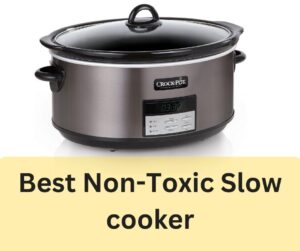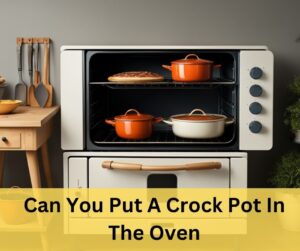Glass top stoves, also known as ceramic top stoves or flat top stoves, are a popular choice for many homes because they have a sleek, modern design with a smooth, easy-to-clean cooking surface. Typically, they are constructed of glass or ceramic and supported by a metal frame. A glass-top stove has a smooth, flat surface with heating sources hidden underneath.
Can You Use A Pressure Cooker On A Glass Top Stove:
This enables uniform heating and exact temperature control. Any cookware that works with a smooth surface, such as flat-bottomed pots and pans, may be used with glass-top stoves. However, it’s vital to exercise caution when using these stoves since if heavy or pointed things are placed on the surface, they might easily be scratched or hurt.
Can You Use A Pressure Cooker On A Glass Top Stove

As long as the pressure cooker is suitable for a cooktop with a smooth surface, you may use one on a glass-top stove. Making ensuring the pressure cooker is solid and correctly positioned on the stove is crucial. In order to shield the glass surface from extreme heat and prevent scratches, it is also a good idea to place a trivet or heat-resistant cushion between the pressure cooker and the burner.
When using a pressure cooker on a glass-top stove, it’s crucial to adhere to the manufacturer’s instructions because certain models may have unique requirements. In general, it is advised to cook with a pressure cooker on a glass-top stove at a medium to low heat setting to prevent scratching the surface. To avoid scratching or breaking, it’s also a good idea to stay away from using metal utensils or setting heavy pots or pans on the glass surface.
How Do You Use a Pressure Cooker on a Glass Cooktop?
Using a pressure cooker on a glass stove top requires the following general precautions:
- Make sure the cooktop has a flat surface and that the pressure cooker is compatible with it. To get exact directions, see the manufacturer’s instructions.
- Set up the pressure cooker on the burner in a sturdy, evenly-balanced position.
- To avoid scratches and to protect the glass surface from overheating, place a trivet or heat-resistant cushion between the pressure cooker and the burner.
- Use the pressure cooker as directed by the manufacturer, paying attention to the suggested heat setting and cooking periods. When using a pressure cooker on a glass-top stove, it is often advised to cook on a medium to low heat setting to protect the surface.
- When handling the pressure cooker, exercise caution since it will be hot and could leak steam. To prevent burns, gently remove the pressure cooker’s cover and handle it using oven gloves or tongs.
- To prevent scratching or breaking, stay away from using metal utensils or setting heavy pots or pans on glass surfaces.
- After cooking is complete, let the pressure cooker cool completely before cleaning it. For pressure cooker upkeep and cleaning, according to the manufacturer’s guidelines.
By following these guidelines, you can safely and effectively use a pressure cooker on a glass-top stove.
The heaviest thing a glass stove can support
The maximum weight a glass top stove can support can vary depending on the type and its construction. As they will include the suggested weight restrictions for pots and pans, it is crucial to adhere to the manufacturer’s recommendations and rules when using the stove. Generally speaking, it is advised to use caution while setting heavy pots or pans on a stovetop with glass to prevent scratching the surface.
A glass top stove’s surface can be damaged by laying heavy or sharp things on it, which is a good idea to avoid. Use a trivet or other heat-resistant mat to disperse the weight of a heavy pot or pan on the stove and shield the surface from damage.
In order to keep a glass-top stove in excellent condition and to avoid accidents or damage, it is crucial to employ caution and care when using it.
What shouldn’t we cook on a stove with a glass top?
There are several cooking methods that might not be appropriate for a glass-top stove or would need extra attention and care. When using a glass-top stove, keep the following factors in mind:
- Avoid using heavy pots or pans: To prevent scratching the glass top of your stove, it is typically advised to take caution when putting heavy pots or pans on it. Use a trivet or heat-resistant pad to disperse the weight of a heavy pot or pan and safeguard the stovetop if you must use one.
- Avoid using things that are sharp or abrasive since they may easily scratch or destroy glass top stoves. To minimize scratching or cracking, it’s crucial to refrain from using metal utensils or setting sharp things on the stovetop.
- Use low heat instead of high heat: The surface of glass top stoves is delicate and can be damaged by excessive heat. When cooking on a glass-top stove, it is often advised to utilize medium to low heat settings in order to protect the surface.
- Avoid placing things that are heavy or sharp on the surface: Objects that are heavy or sharp should not be placed on the surface of a glass top stove as they may scratch or break the surface.
Can a pressure cooker damage your glass-top stove?
A pressure cooker can potentially damage a glass-top stove if it is not used properly. It is important to follow the manufacturer’s instructions for using the pressure cooker, as well as the guidelines for using a glass-top stove.
Here are a few things to consider when using a pressure cooker on a glass-top stove:
- Make use of a trivet or heat-resistant pad: By putting a trivet or heat-resistant pad between the pressure cooker and the burner, you may shield the glass surface from high heat and avoid scratches.
- Use the proper heat setting: To prevent scratching a glass-top stove, it is normally advised to use a medium to low heat setting while using a pressure cooker. A higher heat setting may increase the risk of the stovetop surface cracking or scratching.
- Use plastic or wooden utensils instead of metal ones when using a pressure cooker on a glass-top stove since metal utensils can scratch or chip the surface.
- Avoid placing things that are heavy or sharp on the surface: Objects that are heavy or sharp should not be placed on the surface of a glass top stove as they may scratch or break the surface.
When using a pressure cooker, you may avoid breaking your glass-top stove by adhering to these rules. Additionally, it is a good idea to frequently check the stove’s surface for dings or other damage and to clean and maintain the stove as directed by the manufacturer.
Conclusion
As long as the pressure cooker is compatible with a smooth surface cooktop and the stove is operated in accordance with the manufacturer’s instructions, it is feasible to use a pressure cooker on a glass-top stove. Use a trivet or other heat-resistant pad between the pressure cooker and the stove, adjust the heat level appropriately, stay away from metal utensils, and avoid laying heavy or sharp things on the surface to prevent damage to the stove. You can operate a pressure cooker on a glass-top stove safely and successfully by according to these instructions.



